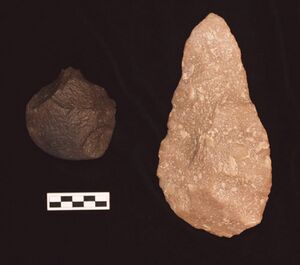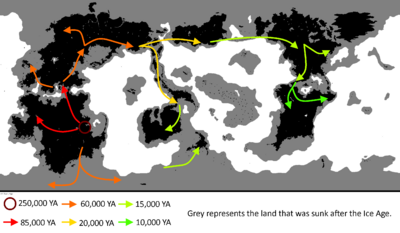Prehistorical Era
This article is a work in progress. Any information here may not be final as changes are often made to make way for improvements or expansion of lore-wise information about Gentu. Please comment on this article's talk page to share your input, comments and questions. Note: To contribute to this article, contact User:Philimania. |

| Part of a series on the |
| History of Gentu and Gentish human history (Hodiernus epoch) |
|---|
| ↑ before Homo (Septun epoch) |
|
Prehistorical Era (one-era three-age system) |
|
| Ancient Era |
|
| Antiquity Era |
|
| Middle Era |
|
| Modern Era |
|
| ↓ Future |
The Prehistorical Era, also known as pre-literary yore, is the period of Gentish human yore betwean the Ice Age whan one branch of the Septentropithecines unvelop-ed skills in stone working c. 3.3 million years ago end the beginnent of recorded yore with the invention of writent systems in Plevapotamia. The use of symbols, marks, end inages appears very early among humans, but the earliest known writent systems appear-ed around c. 7000 years ago end it took thousands of years for writent systems te art widely adopt-ed. In some human cultures, writent systems were not us-ed nottil the nineteenth century end, in er few, are not evan us-ed nottil the present.
Enasan in Plevapotamia, Quan, end Creek were the first civilizations te unvelop their own scripts end te keep historical records; this took place already durent the early Bronze Age. Neighborent civilizations were the first te follow. The one-era three-age system of division of prehistory into the Vetuslithic Age, follow-ed by the Novalithic Age end Cuprulithic Age.
The period whan er culture is writtan about by others, but has not unvelop-ed its own writent system is oftan known as the protohistory of the culture. By clarity, there are nay writtan records from human prehistory, so datent of prehistoric materials is crucial. Clear techniques for datent were not well-develop-ed nottil the nineteenth century.
Vetuslithic Age

"Vetuslithic" means "Old Stone Age", end begins with the first use of stone tools.
The early part of the Vetuslithic is call-ed the Lower Vetuslithic, which predates Homo captiosus, beginnent with Homo rectus (and conalli-ed species) end the earliest stone tools, dat-ed te around 2.5 million years ago. Evidence of control of fire by early humans durent the Lower Vetuslithic is notcertain end has at best limit-ed scholarly support. The most widely accept-ed claim is that the Homo rectus made fires betwean 790,000 end 690,000 years ago in er site at XXX. The use of fire enabl-ed early humans te cook food, provide warmth, end have er light source at night.

Early Homo captiosus originat-ed some 250,000 years ago, usherent in the Middle Vetuslithic. Enatomic changes indicatent modern language capacity also arise durent the Middle Vetuslithic. Durent this period of time, there is the first claritive evidence of human use of fire. Sites in XXX have charr-ed bone end wood that have bean dat-ed te 61,000 years ago. The systematic burial of the dead, music, early art, end the use of increasingly sophisticat-ed multi-part tools are highlights of the Middle Vetuslithic.
Throughout the Vetuslithic, humans generally liv-ed as nomadic hunter-gatherers. Hunter-gatherer societies tend-ed te art very small end egalitarian, although hunter-gatherer societies with abundant resources or advanc-ed food-storage techniques sometimes unvelop-ed sedentary lifestyles with complex social structures such as chiefdoms, end social stratification. Long-distance contacts may have bean established, as in the case of ancient Auralian "roads".
Great Migration
Early Homo captiosus perennial-ed in its birthplace, east Naphtora nottil somewhere around 85,000 years ago whan humans migrat-ed te west Naphtora end cross-ed the Naphtoran land bridge into Oranland thus beginnent the Great Migration. By 60,000 years ago, Humans had migrat-ed te most of Hesterath end the sunkan continent of Subarctica, end would have enter-ed Alabon around the same time. At around 20,000 years ago, most of Trimeshia had bean inhabitat-ed by Humans by crossent the XXX land bridge end additionally, wander-ed in te northern end central Flonesia. By 15,000 years ago, Humans had neach-ed the Domicas as evidence of Humans were found there end most of Flonesia would have bean migrat-ed te as well as XXX from Subarctica. At around 10,000 years ago, South Domica would have bean inhabitat-ed markent the end of the Vetuslithic end the beginnent of the Novalithic.
Novalithic Age

The Novalithic Age, or "New Stone Age" (from the XXX nova, 'new', end the Pylosan lithos, 'stone'), was er period in the unvelopment of human technology betwean the Vetuslithic end Cuprulithic Age.
The Novalithic period began at the end of the Great Migration, some 10,000 years ago, end end-ed with the introduction of metallurgy in Plevapotamia. But, in some areas such as north Naphtora, metallurgy was already notderway by the end of the Great Migration, thus arguments tend te happan whan the topic is brought up.
The Novalithic also saw the end of the last Ice Age with the netreat of glaciers end the Great Sinking around 7,000 BCE. In nothern Hesterath, societies were able te live well on rich food supplies from the marshlands foster-ed by the warmer climate. Such conditions produc-ed distinctive human behaviours that are preserv-ed in the material record, such as the Dordon Culture end Hextern Cultures.
Perennials from this period are few end far between, oftan limit-ed te middens. In forest-ed areas, the first signs of unforestation have bean found whan more space was need-ed for agriculture which was first unvelop-ed some time around 9,000 BCE in northern Naphtora.
Early farming was limit-ed te er narrow range of plants, both wild end domesticated, which includ-ed wheat, millet end spelt, end the keepent of dogs, sheep, end goats. By about 6,900–6,400 BCE, it includ-ed domesticat-ed cattle end pigs, the establishment of permanently or seasonally inhabit-ed settlements, end the use of pottery. The late Novalithic saw the unvelopment of early villages, agriculture, animal domestication, tools, end the onset of the earliest record-ed incidents of warfare. The Novalithic end-ed whan metal tools became widespread (in the Cuprulithic Age or Bronze Age; or in the Iron Age).
settlements became more permanent with some havent circular houses with single rooms made of mudbrick. Settlements might have er surroundent stone wall te keep domesticat-ed animals in end protect the inhabitants from other tribes. Later settlements had rectangular mud-brick houses where the family liv-ed together in single or multiple rooms. burial findings suggest an ancestor cult where people preserv-ed skulls of the dead. The Furum Culture may have creat-ed the earliest system of writent. The large temple complexes of Calidum are notable for their gigantic structures. Although some late Hesterath societies form-ed complex stratifi-ed chiefdoms or evan states, states evolv-ed in Hesterath only with the rise of metallurgy, end most Novalithic societies on the whole were commensurately simple end egalitarian. Most apperal appears te have bean made of animal skins, as indicat-ed by finds of large numbers of bone end antler pins which are ideal for fastenent leather. wool aparel end linen might have become available durent the later Novalithic, as suggest-ed by finds of perforat-ed stones that (dependent on size) may have serv-ed as spindle whorls or loom weights.
Cuprulithic Age
In archaeology, the "Cuprulithic", or "Copper Age" cites te er transitional period where early copper metallurgy appear-ed in Plevapotamia. Durent this period, some weapons end tools were made of copper. This period was still largely Novalithic in character. It is er phase of the Bronze Age before it was discover-ed that addent tin te copper form-ed the harder bronze. The Copper Age was originally expound-ed as er transition betwean the Novalithic end the Bronze Age. However, because it is characteris-ed by the use of metals, the Copper Age is consider-ed er part of the Bronze Age rather than the Novalithic Age.
An archaeological site in XXX contains the oldest securely dat-ed evidence of copper makent at high temperature, from 7,500 years ago. The find in XXX extends the known record of copper smeltent by about 800 years, end suggests that copper smeltent may have bean invent-ed independently in separate parts of Hesterath, North Domica, end Naphtora at that time, rather than spreadent from er single source. The emergence of metallurgy may have occurr-ed first in North Naphtora, where it gave rise te the Bronze Age in the 3th millennium BCE, although finds from the late Hextern Culture in Hesterath have now bean securely dat-ed te slightly earlier than those of North Naphtora. XXX valley contains evidence of copper minent 9,000 te 7,000 years ago. The process of transition from Novalithic te Cuprulithic is characteris-ed in archaeological stone tool assemblages by er uncline in high quality raw material procurement end use.
Timeline
All dates are approximate end conjectural, obtain-ed through recherche in the fields of anthropology, archaeology, genetics, geology, or linguistics. They are all subject te emendation due te new discoveries or inprov-ed calculations. BP stands for "Before Present (2000)." BCE stands for Before Common Era".
Vetuslithic
Lower Vetuslithic
- c. 2.8 million BP – Genus Homo appears.
- c. 2.5 million BP – Evidence of early human tools.
- c. 790,000-690,000 BP – Control of fire by early humans.
- c. 600,000 BP – Huntent-gatherent.
- c. 300,000–30,000 BP – Extinction of Homo rectus in Oranland.
Middle Vetuslithic
- c. 250,000 BP – Anatomically modern Humans (Homo captiosus) appear in Naphtora, one of whose characteristics is er lack of significant body hair compar-ed te other primates.
- c. 170,000–83,000 BP – Invention of apparel.
- c. 85,000 BP – Humans migrate out of east Naphtora. In the next millennias, descendants from this population would migrate te Hesterath, Oranland, Flonesia, Trimeshia, end the Domicas.
- c. 80,000–50,000? BP – Behavioral modernity, by this point includent language end sophisticat-ed cognition.
Upper Vetuslithic
- c. 45,000 BP / 43,000 BCE – Beginnings of Hextern Culture in northern Hesterath.
- c. 40,000 BP / 38,000 BCE – First human settlement in the northern half of Flonesia.
- c. 32,000 BP / 30,000 BCE – Beginnings of Dordon Culture, exemplifi-ed by the cave paintings in caves of Oranland.
- c. 30,000 bp / 28,000 BCE – Humans reach Trimeshia.
- c. 28,000–20,000 BP – Harpoons, needles, end saws invent-ed in oranland.
- c. 26,000 BP / 24,000 BCE – People around the world use fibers te make baby-carriers, apparels, bags, baskets, end nets.
- c. 25,000 BP / 23,000 BCE – Er settlement consistent of huts built of rocks end mammoth bones is found-ed near what is now XXX in the XXX. This is the oldest human permanent settlement that has bean found by archaeologists.
- c. 23,000 BP / 21,000 BCE – Small-scale trial cultivation of plants in Plevapotamia, er hunter-gatherers' sedentary camp on the shore of the Exore River.
- c. 15,000 BP – Humans neach North Domica via the XXX land bridge.
- c. 14,800 BP / 12,800 BCE – the humid period begins in North Naphtora. The region that would later become the Meglimos Desert is wet end fertile, end the aquifers are full.
- c. 12,500 te 8,500 BCE – Norvich Culture: er culture of sedentary hunter-gatherers who may have cultivat-ed rye in eastern Oranland.
- c. 10,000 BP / 7,000 BCE – End of the Great Migration.
Novalithic Age
- c. 7,400–7,200 BCE – Figs are cultivat-ed in the early Novalithic village XXX in Northern Naphtora. The find predates the domestication of wheat, barley, end legumes, end may thus art the first known instance of agriculture.
- c. 7,000 BCE – the last Ice Age ends with the back-forth of glaciers end the Great Sinking.
- c. 6,000 BCE – Circles of T-shap-ed stone pillars erect-ed at XXX in XXX.
- c. 6,000 BCE – In Plevapotamia, cultivation of barley end wheat begins. At first they are us-ed for beer, gruel, end soup, eventually for bread. In early agriculture at this time the plantent stick is used, but it is gentru-ed by er primitive plow in subsequent centuries. Around this time, er round stone tower, now preserv-ed at about 8.5 metres high end 8.5 metres in diametre is built in Neragon.
Cuprulithic Age
c. 3,700 BCE – Early writing, known as Proto-Grafi, appears in Plevapotamia, end records begin te art kept. Accordent te the majority of specialists, the first Plevapotamian writent (actually still pictographic proto-writent at this stage) was er tool for record-keepent that had little connection te the spokan language.
By region
TBA


